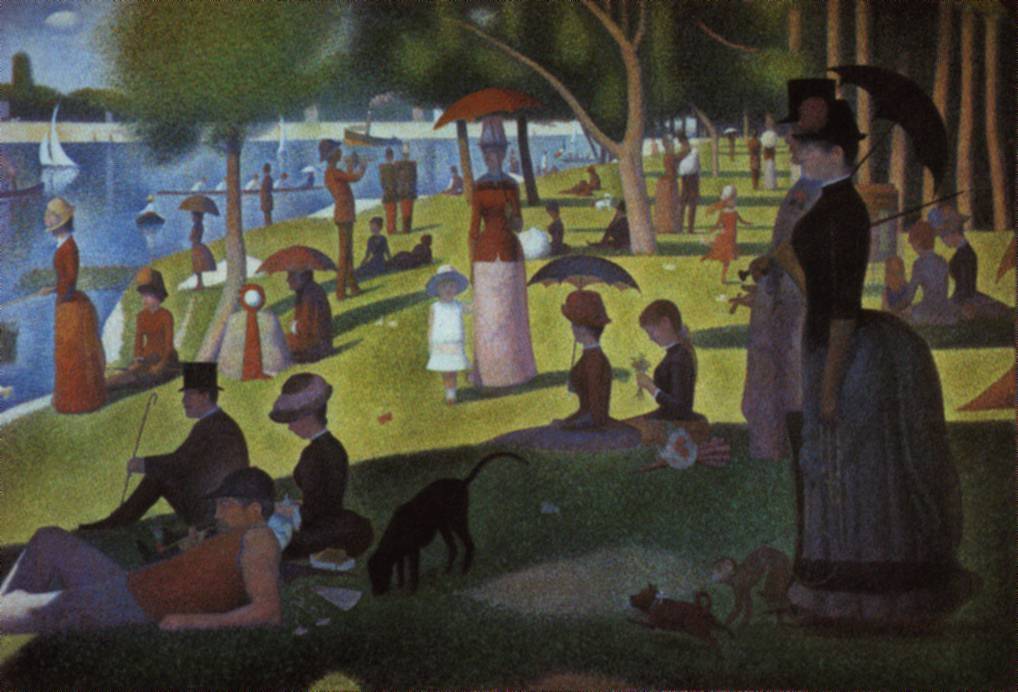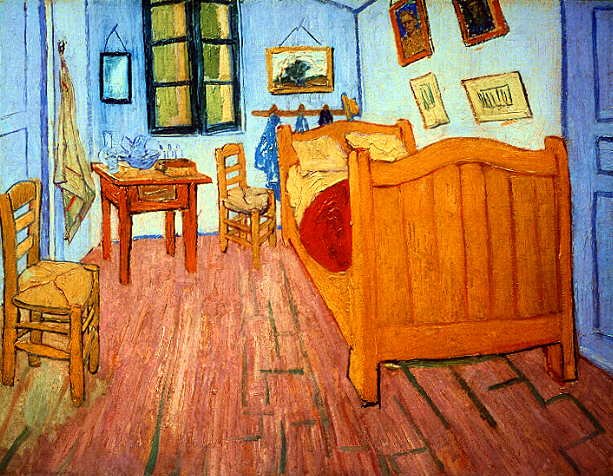 Sunday Afternoon on the Island of La Grande Jatte,Georges Seurat,1884-86; Art Institute of Chicago, Helen Birch Bartlett Collection
Sunday Afternoon on the Island of La Grande Jatte,Georges Seurat,1884-86; Art Institute of Chicago, Helen Birch Bartlett Collection
In the 20th century, a multitude of revolutionary artistic schools emerged. There are three major trends: Cubism (1909-1912 , Picasso and Braque), Impressionism and Surrealism.
The Cubists, with their analytical decomposition of space into facets, are the direct heirs of Cezanne. Guillaume Apollinaire in The Beginnings of Cubism, 1912 expresses well the revolutionary concept of cubism:
The art of painting original arrangements composed of elements taken from conceived rather than perceived reality.
. Theoretically the medieval painter could already have been considered a Cubist, since the unawareness of the perspective rules forced him to find his own spatial composition through intuition. However, the Cubists understood the rules of perspective and deliberately broke the rules of perspective to express a new concept of abstraction, fragmentation and depth. Their theories are the basis of non-objective painting in modern art (Kandinsky, Mondrian ...) and of the concept" Everything is art.
The Impressionist, on the other hand, was mainly concerned in depicting the appearances conditioned by time, space, light and atmosphere. Atmospheric depth was created in Massaccio's art. In fact, the luminosity of an object is inversely proportional to the square of the distance to the light source. The main idea is that colors are more intense in the front and fade away when moving into space. This concept of aerial perspective compounded with the emphasis on light, using a minimum of shadow within the framework of the chiaroscuro are the direct roots of impressionism. In this sense the Luminists- Titian, Velasquez and Vermeer- inaugurated Impressionism. Naturally, next to perspective, light is the most vital component in illustrating space on a flat picture. Impressionism became very popular and risked becoming decorative painting. Next to Seurat (pointillism-aerial perspective), Gauguin (naiv art), Van Gogh is one of the of few impressionists, who adapted the new concept of light and space to his own means. In his "Bedroom at Arles", Van Gogh expresses his paranoia through perspective distortion.
 Sunday Afternoon on the Island of La Grande Jatte,Georges Seurat,1884-86; Art Institute of Chicago, Helen Birch Bartlett Collection
Sunday Afternoon on the Island of La Grande Jatte,Georges Seurat,1884-86; Art Institute of Chicago, Helen Birch Bartlett Collection
 Vincent's Room, Arles
,1888; Vincent Van Gogh
Foundation, Amsterdam
Vincent's Room, Arles
,1888; Vincent Van Gogh
Foundation, Amsterdam
In fact distortion and extreme point of views can be considered as a major use of perspective in the 20th century art to express unconscious reality. It expresses paranoia and stress. Hitchcock in his movies used this phenomena to create suspense. The examples range from "The scream" of Edward Munch, to the optical games of M.C. Escher. In the 1960's, everything was legitimately considered art. Pop Art (Andy Warhold, Roy Lichtenstein, David Hockney..) elevated commercial advertisements and products, comics and clichés to art. Art became subdivided into millions of different concepts. Some of them even deny any influence of the modern schools. The academists for example, learned a few basic concepts in perspective to create a non-controversial picture based on old masters. The Mexicans Rivera, Orozon and Siquieros depict the history and tradition of their country inspired directly from the gigantic mural paintings of the Renaissance.
Until the 19th century the main role of perspective was to recreate optical reality and it is photography which took over this charge. Perspective is no longer a necessary tool for 20th century artist. Contrary to Cubism, where its role could be defined by its denial, perspective is a major tool in surrealism.
Dali and a new role of perspective in artt
Salvador Dali (1920-1980), is one of the major leaders of Surrealism where metaphors and dreams are illustrated with the precision of the techniques of the old masters In fact, it was Salvador Dali's work that inspired my interest in perspective. Most of his paintings have a similar set up: he uses a very low point of view and simplifies the ground by a flat surface. This leaves a major part of the canvas space to the sky. The resulting infinite space is one of his basic frameworks. The canvas becomes a window into the realm of the unconscious. The strong shrinkage resulting of such a set-up enables the viewer to look deep into the surrealistic space. He also uses symbolism and suggestive drawings to activate the viewers unconsciousness. Salvador Dali
In his art, Dali extracts perspective phenomena that one encounters in real life, into an imaginary world. Since the viewer seeks beauty in familiar pattern, as Prof. Banchoff mentioned in his course "The mathematical way of thinking" (Brown University, sem.II 1996), perspective becomes a tool of creating a "realistic/believable" impression of an imaginary world.
Here some of my favored paintings:
La Tentation de Saint Antoine., Salvador Dali, 1946
La Gare de Perpignon., Salvador Dali, 1965
Toreador hallocinogene, Salvador Dali, 1969/70
Go on to next section: Conclusion
Return to the table of contents.